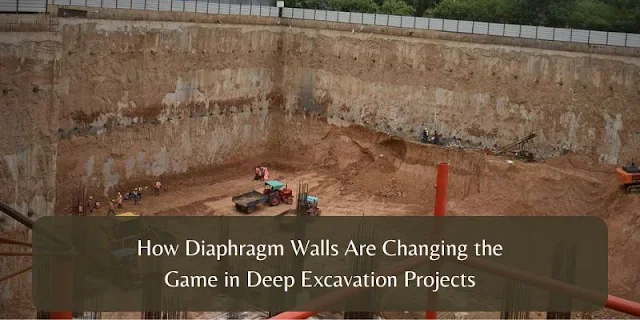How Diaphragm Walls Are Changing the Game in Deep Excavation Projects
Urbanization has led to an increasing demand for underground infrastructure, including basements, metro stations, tunnels, and parking structures. As cityscapes evolve, the need for deep excavation techniques that are both safe and efficient has never been more critical. One method that has gained tremendous attention in recent years is diaphragm wall construction—a specialized technique that enables engineers to support large excavations, especially in densely populated urban areas.
Unlike conventional methods, this process provides greater stability and minimizes disturbance to nearby structures, making it ideal for space-constrained environments. It also plays a vital role in groundwater control and structural load resistance, which are essential for deep excavation. With increasing pressure on optimizing both time and budget in infrastructure projects, wall construction offers a reliable solution that's changing how engineers plan and execute such endeavors.
The Evolution of Excavation Support
Traditionally, excavation support was provided by simpler techniques such as sheet piling, secant pile systems, or soldier pile walls. These systems, while still in use, have limitations in terms of depth, water tightness, and structural integrity in soft soil conditions. As the complexity of urban infrastructure projects increased, the need for a more robust and durable system emerged.
That’s where modern slurry trenching techniques brought a revolution. These methods allowed for the creation of continuous underground barriers that could reach significant depths and manage high earth and water pressures. This advancement opened up new possibilities in geotechnical engineering, particularly for projects in seismic zones or areas with a high water table.
Advantages in Urban Settings
In bustling urban environments, space is always at a premium. Building below ground without affecting nearby roads, buildings, or utilities is a massive challenge. One of the biggest advantages of diaphragm construction is its low impact on surrounding infrastructure. It requires less horizontal space for setup, and the equipment can often be mobilized in tight, congested sites.
Additionally, the method generates minimal vibration and noise, which is crucial when working in sensitive areas like hospitals, heritage sites, or active commercial zones. Because it can be installed before excavation begins, this technique also provides immediate ground support, reducing the risk of collapse or shifting during subsequent work stages.
Structural Efficiency and Versatility
Beyond excavation support, these vertical elements can double as permanent structural components. Once excavation is completed, the embedded concrete segments can serve as part of the foundation system. This dual function not only reduces the need for additional structural work but also shortens the overall timeline for project delivery.
Whether used in basements, underpasses, or underground stations, the method can be tailored for different soil types and load-bearing requirements. From soft clay to dense sand and even hard rock, variations in slurry mix and excavation techniques allow for customization across a wide range of environments.
Environmental and Cost Benefits
In addition to its technical strengths, this method offers several sustainability and financial advantages. For example, the use of bentonite slurry during trenching helps limit spoil generation and improves wall quality. Less waste means lower disposal costs and a smaller carbon footprint.
Because it minimizes the need for extensive dewatering and other environmental disruptions, this system also aligns well with green building standards. The long lifespan and low maintenance of the resulting barriers contribute to long-term cost savings, particularly for public infrastructure projects with tight budgets and high usage expectations.
These combined benefits make construction one of the most cost-effective solutions for modern deep excavation. It’s no surprise that developers and engineers across the globe are turning to this method for a wide range of applications.
Innovation Through Technology
Recent advancements in digital technology have further enhanced the precision and monitoring of deep excavation methods. Tools like 3D modeling, real-time sensor monitoring, and automated trench cutters allow for greater control and predictability during installation.
Digital tools also enable teams to simulate different scenarios and respond quickly to on-site challenges. These capabilities are vital when working under difficult geotechnical conditions or when facing unexpected groundwater inflows.
Incorporating these technologies into diaphragm wall construction practices ensures not only higher accuracy but also improved safety for workers and reduced risks for project owners.
Real-World Applications and Future Outlook
From metro systems in Delhi to high-rise basements in Mumbai and infrastructure upgrades in Chennai, India has witnessed a significant uptick in the use of this method. Its ability to handle large-scale urban challenges makes it a preferred option for future-ready infrastructure.
The increasing focus on smart cities and underground space utilization suggests that the demand for advanced excavation methods will only grow. As developers continue to push the boundaries of what’s possible below ground, the role of diaphragm techniques is set to become even more central.
Conclusion
As urban development reaches new depths—literally and figuratively—the need for safe, efficient, and technically sound excavation methods becomes paramount. Diaphragm wall construction has emerged as a game-changer in this space, offering unmatched stability, adaptability, and environmental compliance for deep excavation projects.
With continued innovation and expanding adoption, it stands as a cornerstone of modern geotechnical engineering. From commercial high-rises to transit corridors, the applications are vast, and the benefits undeniable.

.jpg)
.jpg)

Comments
Post a Comment